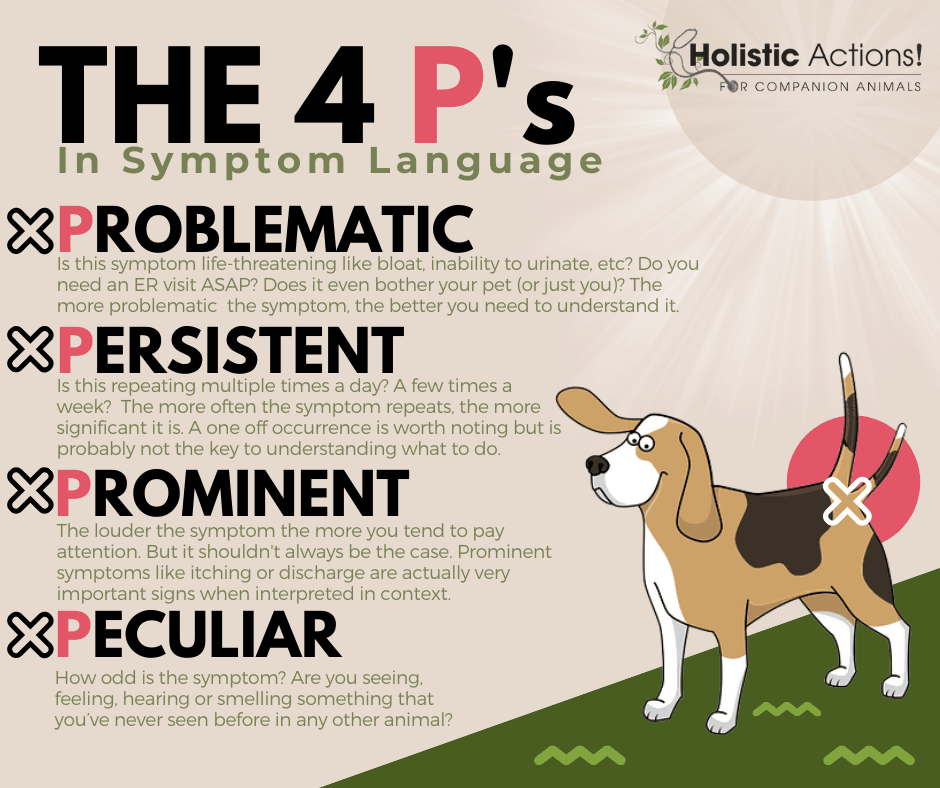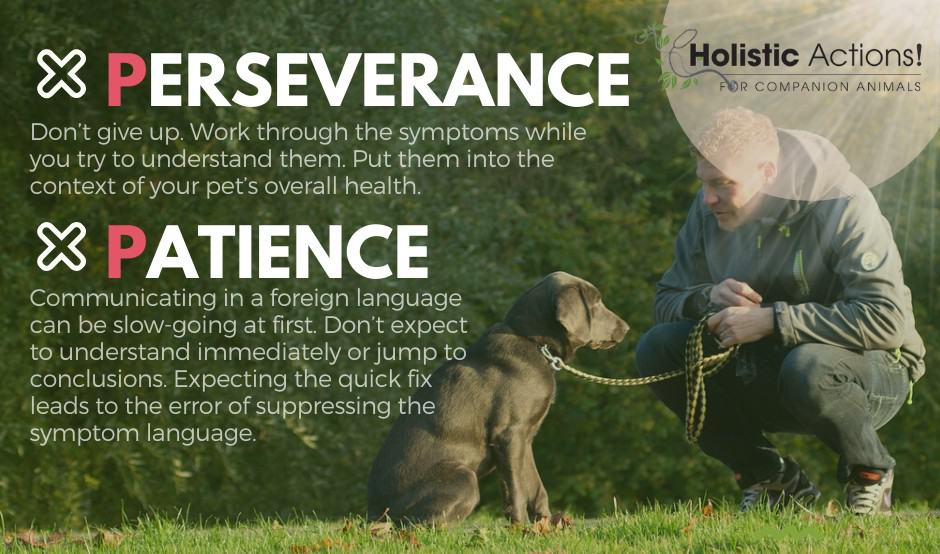Learning to view your pet’s symptoms as trustable, intelligible communications that can provide clues to underlying imbalances and guide holistic health interventions is one of the most important things you can do.
This is often a difficult task, since almost all of us have been conditioned to view symptoms as an enemy that we must medically defeat. But symptoms are not our enemy but our ally, and this reversal of perspective is one of the most rewarding you can take; not only for your pet’s life, but for your life.
When your pet’s symptoms are not viewed as something to fear but as something valuable to which you can listen and from which you can learn, it quickly becomes apparent that they offer a breadtrail to the very solutions you are seeking — holistic actions that don’t just cover up or quiet down symptoms, but that create new levels of inner balance and vitality to make your pet’s system even more resilient against dis-ease.
A Quick Word About the Difference Between Signs and Symptoms
It bears noting here that what we’re calling in this article “symptoms” are understood medically as “signs.” Technically, symptoms refer to indications of distress or dis-ease that are subjective and therefore invisible, such as the particular quality of pain or the experience of having a nightmare.
Because animals aren’t able to tell us about symptoms, we must technically go on signs. Signs are indications of distress or dis-ease that may not be outwardly visible, such as elevated white count, fever, and so forth. Another way to understand the difference between symptoms and signs is that the first is subjective and the second is objective. But for the purpose of this article, we’re just using a single term — symptoms — to refer to both.
The real question now is how you can have a “conversation” with your pet by listening to their symptoms in order to learn from them? The 4 P’s methodology we’re about to teach you will give you tools for doing this and transform your capacity to respond appropriately to what your pet’s system is telling you.
Without Further Ado…The 4 P’s!
The 4 P’s offer a listening framework to help you approach symptoms with the right mindset and the right questions.
- Pay attention to Problematic symptoms: Health challenges that may limit your pet’s life, like obesity or chronic allergies.
- Pay attention to Prominent symptoms: Those that most loudly say, “Pay attention to me!” Acute dis-ease symptoms fall into this category.
- Pay attention to Persistent symptoms: How often do you see the symptom? Hourly symptoms are usually more significant than weekly.
- Peculiar Symptoms: Have you ever seen this symptom before in your pet or anyone’s pet or does it strike you as particularly odd or usual?

And here’s two other P’s that help you work with your pets bodies and symptoms and not suppress them:
- Approach symptoms with Patience: Deep and permanent healing occurs slowly.
- Approach symptoms with Perseverance: You might need a new approach or different (not just a second) opinion. Don’t give up!

BEAM — Another Helpful Framework for Listening to and Learning from Your Pet’s Symptoms
BEAM should be improving over time.
This basic BEAM model of four symptom categories provides an additional framework for understanding and assessing symptoms. BEAM stands for Behavior, Energy, Appetite, and Mood. The Beam models helps shine the light on optimal long term health and to provide an overarching context for viewing symptoms.
When it comes to holistic strategies for your pet, BEAM should be improving over time. It’s extremely important to track changes in BEAM symptoms, especially if they are Prominent, Persistent, Problematic or Peculiar.
So ask yourself, which categories do my pet’s symptoms fall into? The more categories in which symptoms appear, the more urgent is the need for intervention to restore or improve your pet’s inner balance and vitality.
Symptoms that Change In Response to Environmental Changes (“Modalities”)
Pay especially close attention to symptoms that change depending on the context. They are among the clearest communications you will receive from your pet’s system. These symptoms may appear…
- When you get ready to leave the house or come home from work, with your pet becoming especially clingy or needy, or going off by themselves at specific times of day or night.
- In weather conditions like heat, cold, rain, wind, etc.
- During or after: eating, drinking, waking, defecating, urinating, etc.,
- In relation to certain foods. (Fresh feeding of a variety of foods makes symptoms like this much easier to recognize.)
- And more!
Symptoms that occur at the same time, or what are known as concomitant symptoms, can also be very significant. For example vomiting along with diarrhea, increased drinking along with sneezing, etc.
Additional Considerations and Questions for Collecting Clues
Keep a daily log of symptoms and carefully record any changes, no matter how seemingly insignificant. Changes in your pet’s usual patterns and habits as viewed through the BEAM model are especially significant, even if they appear to you to have nothing to do with your pet’s problem. Where relevant, record the answers to the following questions in your log to collect the clues you need for helping your pet.

- When did the problem begin and what circumstances were associated with it or may have brought it on?
- Have there been previous illnesses such as ear and eye “infections”, allergies/skin diseases, colds, skin growth removals, urinary problems, etc.?
- Specifically, which treatments were used, for how long and what doses were any drugs used? What were the results?
- How about new symptoms associated with a medication (no matter how benign you were told that it is)?
- Are there any conditions that started along with the main problem you’re concerned about?
- Is there a time of day, night, month, or season that the symptoms are better or worse? Are they better or worse before or after eating, sleeping, moving, resting, or when your pet is occupied with a favorite activity? (Anything that makes the symptoms better or worse is extremely important to note.)
- Do symptoms appear at a specific time, season, phase of the moon, temperature/barometric pressure etc.? For example, is joint stiffness worse when it is humid?
- Do the symptoms remain the same or do they change character or shift from place to place?
Narrow Your Focus to Gather Even More Clues!
The real breadcrumbs to the solutions you’re seeking are found in the details! By focusing on the following areas, you’ll be led that much closer to the right holistic actions to take for your pet!
APPETITE
- How is your pet’s appetite? Does she beg for food and always appear hungry? Is there an increase or decrease in appetite?
- Does your pet’s appetite seem excessive or are they inexplicably picky?
Does your pet seem preoccupied with particular kinds of food or with particular flavor profiles or textures? (Salty, sweet, fatty, sour, spicy, egg-like, or ice cubes?) - Does your pet trying to eat non-digestible items like dirt, rocks, sand, stool, pencils, etc.?
- Is your pet fed in a crate, and if so, why?
- Does your pet eat out of a bowl or need to be hand-fed?
- How fast does your pet eat? Does she take a few bites or eat all of the food right away?
BEHAVIOR
- Have there been behavioral changes such as being easily startled or starting from sleep or seeming sensitive to being touched?
- Do these behavioral changes improve or worsen with diversion such as a walk or car ride? Is your pet’s reaction to you opposing certain behaviors (like jumping up on somehow) any different than usual?
- Is your pet behaving differently with guests or interacting with strangers in ways you’ve never before witnessed? Does your pet actively avoid interaction or retreat to a room by themself to seek solitude?
- Has your pet become more or less reactive to small animals, other dogs or people? How long after an encounter with one of these does reactivity occur? Is it expressed through jumping, lunging, barking, growling, trembling, or cowering?
- Does your pet appear restless or unable to settle down?
- Do they suddenly begin to avoid hard surfaces or seek out hard surfaces to lie on, and rest in positions they have not favored before?
- Do they prefer sun or shade more frequently than normal, or do you notice unusual or extreme behavior changes in relation to temperature changes?
- If your pet is involved in any kind of training, do you notice an increase or decrease in focus, a change in excitement level or loss of motivation in response to using food, toys, and praise as a reward?
- Do you notice a sudden reluctance to sit, heel, etc., or a sudden change in your pet’s attitude toward training?
- Is your pet vocalizing and/or moving in their sleep in ways you’ve never seen before? If so, are you seeing whining, barking, snoring, paws or legs twitching (all paws?), or they’re legs moving as though they are running?
BATHING, BRUSHING, PETTING, AND GROOMING
- Does your pet suddenly no longer want to be brushed or pet or seek out brushing or petting when having avoided it in the past?
- Do they suddenly react to brushing or petting in an unusual way such as spinning, whipping their head around, trying to bite you, moving head from side to side, licking the air, or “dancing” with back legs?
- How does your pet react to running water? Does your pet suddenly avoid baths or resist getting out of the bath?
- If your pet is a cat, has their been a reduction or cessation of grooming?
COAT
- Is your pet losing unusual amounts of fur or shedding at unusual times? If so, is the hair falling out evenly or in bunches or tufts?
- Do you note dandruff, dry or brittle fur, a change in your pet’s coat in terms of thickness, shine, dullness, or oiliness?
DISCHARGE
- Discharge details are very important. Are you noticing any discharge from our pet’s nose, eyes, or sex organs? , Is it scant or copious, thick or thin, or sticky? What is the color and odor? Does it appear to be causing irritation to the tissues it’s being discharged?
FEMALE CYCLE
- If your pet is an intact female; how old was she when she first came into heat, how far apart are the cycles, are there any behavior changes or physical symptoms that accompany heat?
- What does the vaginal discharge before, during, and after the heat cycle look and smell like?
- Has she ever been pregnant? Did she breed and conceive easily?
- How did she carry, any problems delivering?
- Did she have plenty of milk? Were there any problems associated with nursing?
LAMENESS AND EASE OF LYING DOWN AND GETTING UP
- Is your pet favoring or protecting a specific foot or holding her paw up?
- Do you notice soreness or swelling to the paw or legs, and when it is genty pressed on, does an indentation occur, and if so, for how long does it stay before returning to normal?
- Does the swelling feel soft or firm, an dis it hot to the touch?
- Does your pet exhibit pain with rotation of what appears to be an afflicted joint?
- Can your pet lie down and get up quickly and easily? Do they lie down with their back legs or front legs first?
- Do they yelp or cry out when they lie down, spin prior to lying down?
- When they lie down, does their back end go down fast but front end slow?
- Does your pet yelp or cry out when getting up or attempt to use a wall or some other source of support for standing?
MASSES | GROWTHS
- Do you notice any masses or growths on your pet? What is the size of these growths? Are they open and expelling fluid or bleeding or emitting odor?
- Are masses soft or hard, painful, and movable?
- Have their been any changes in the shape, size, or growth-rate of a mass?
RESPIRATORY
- Does your pet pant excessively or have trouble breathing?
- Is your pet coughing? If so, what does the cough sound like? (Hacking, rasping, wheezing, wet, or dry?)
- What is the frequency of your pet’s coughing, the time of day it occurs, and the duration of the coughing episode?
- Does the cough coincide with or seem to be triggered by waking up, when on-leash, or after eating or drinking?
- Is your pet sneezing? If so, what is the frequency, time of day, triggers, length of the sneezing episode, and how many sneezes in a row do you count?
SKIN
- Do you note any skin changes or lesions? What is their exact location and color? Are they dry or moist, thick or thin, scaly, or pimply? Are their warts or other growths? Are they dry, flaky, powdery, red or inflamed?
- What about open sores, clogged pores or cysts, or changes in skin pigmentation? What is the appearance of skin overall?
- Is the skin itchy and does your pet seem to get relief from scratching or does that seem to make it worse? Does heat, cold, exercise, wearing a collar, etc., make it better or worse?
STOOL | GI SYMPTOMS
- Does mucus or blood appear in the stool? Does defecation coincide with waking, eating, drinking, etc.?What is the frequency and urgency of defecation? (Does your pet rush to the litter box or to the door at a certain time of the day?)
- What is the odor, color, and consistency of stool? Are the stools very smelly (do they burn your eyes from 6 feet away?). Are they hard, dry, large, pasty, bloody, frothy, slimy, thin, watery, slender, or flat?
- Normal stools are well-formed and are easy to pick up (and don’t leave mush on the ground).
- Soft-formed stools may look the same (or a bit wetter) but are harder to clean up
- Pudding stools are the consistency of soft serve ice cream.
- Watery stools are in liquid form.
- Does stool shoot out like water from a hose with (or without) gas? Is there straining before, during, or after passing stool? Does your pet continue to try and eliminate even after they have defecated? Do you hear (or smell) gas before, during, or after passing a stool? How about noises from the stomach?
THIRST
- Is your pet drinking less or more than usual? Is there thirst for large quantities at one time, small frequent quantities, or little thirst?
- Is there a preference for cool fresh water vs. room temperature or warm water? Is there a preference for water that comes out of the tap, backyard hose, or bathroom toilet?
- Is your pet a “sloppy” drinker? (Does the water go all over the place after a drink?)
URINE
- What is the color, how frequent or urgent is the need to urinate?
- Have there been any accidents or periods of incontinence?
VOMITING OR REGURGITATION
- Is vomiting active or passive? Does vomiting seem painful to your pet? Is there retching?
- What is the vomitus odor, amount, color, and consistency? (Foamy/frothy, lumpy, liquidy, etc.)
- Do there seem to be identifiable food triggers, activity-related triggers, or specific times of the day you witness vomiting? Does it seem in any assoicated with, drinking, going out or coming in, or defecating?
- Do you notice weakness after vomiting?
SEXUAL ISSUES
- Do you notice any male or female sexual issues? Trouble breeding, masturbation, excessive mounting behavior, or penile or vaginal discharges related or unrelated to heat?
The More Clues You Collect, the Better Off Your Pet Will Be!
Holistic Action is here to help you interpret your pet’s symptoms and use them as a trustable guide for taking effective holistic actions — actions that don’t just cover up or quiet down your pet’s symptoms, but that create new levels of inner balance and vitality to give them the happy, healthy life that every dog and cat deserve!
Thank you for visiting us here at Holistic Actions! We wish you the best of luck on your holistic pet care journey!
Be well.
Dr. Jeff
